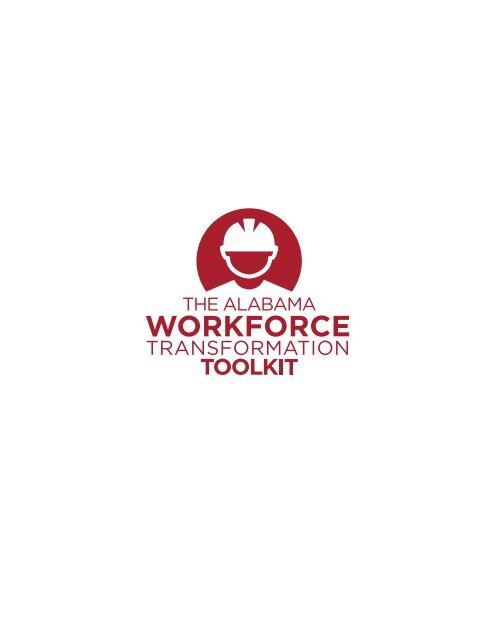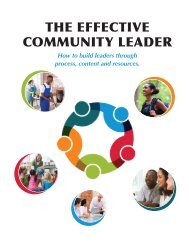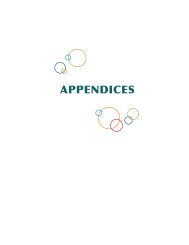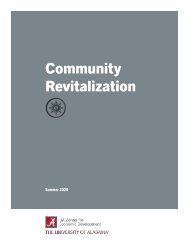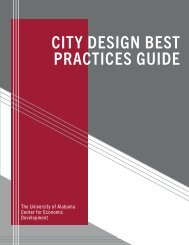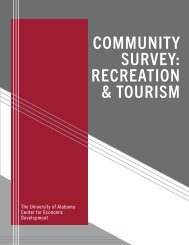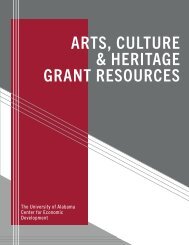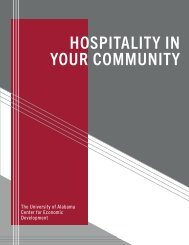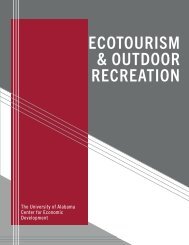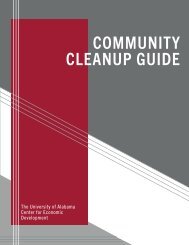Alabama Workforce Transformation
Create successful ePaper yourself
Turn your PDF publications into a flip-book with our unique Google optimized e-Paper software.
The Strong Start, Strong<br />
Finish Education to<br />
<strong>Workforce</strong> System<br />
Governor Ivey launched the Strong, Start Strong Finish education initiative in July<br />
2017 to integrate <strong>Alabama</strong>’s education and workforce development efforts into a<br />
seamless educational journey for all Alabamians. The first phase, Pre to Three,<br />
is focused on securing state-wide saturation for the <strong>Alabama</strong> First-Class Pre-K<br />
Program and ensuring that all of <strong>Alabama</strong>’s third graders are proficient readers<br />
by 2022. The second phase, CS4AL, will ensure that a rigorous computer science<br />
course is offered at all of <strong>Alabama</strong>’s middle and high schools by 2022. The third<br />
phase, Success Plus, will prepare 500,000 more Alabamians to enter the workforce<br />
with high-quality postsecondary degrees, certificates, and credentials by 2025.<br />
With the passage of the Strong Start, Strong Finish legislative agenda (Act 2019-523,<br />
Act 2019-389, and Act 2019-506), Governor Ivey has delivered on the most sweeping<br />
and transformative education agenda since the Brewer Administration. (Please find<br />
links to each of the Strong Start, Strong Finish acts, as well as supporting analysis,<br />
here.)<br />
Governor Ivey has also established five Strong Start, Strong Finish benchmarks. The<br />
five benchmarks are: (1) pre-k readiness by age four, (2) school readiness by age five,<br />
(3) being literate and numerate before the fourth grade, (4) exploring each college<br />
and career pathway before ninth grade, and (5) diverging into a rigorous college or<br />
career pathway leading to a career or matriculation into a postsecondary education<br />
program at the time of high school graduation. Dig deeper into the Strong Start,<br />
Strong Finish Initiative and each of its components here.<br />
2
<strong>Alabama</strong>’s Key Strategies to Align the<br />
<strong>Workforce</strong> System in the Combined 2020<br />
WIOA Plan<br />
Governor Ivey has set a postsecondary education attainment goal of adding 500,000<br />
credential holders to <strong>Alabama</strong>’s workforce by 2025 and a goal to increase <strong>Alabama</strong>’s<br />
labor force participation rate of 57.6 percent to the national average by 2025.<br />
Through the <strong>Alabama</strong> Statewide Consolidated Statewide <strong>Workforce</strong> Development<br />
Strategic Plan, Governor Ivey has set a unified vision for reaching the attainment<br />
and labor force participation goals. By braiding federal and state workforce and<br />
education funding streams to produce an education-to-workforce pipeline that<br />
begins with literacy and numeracy, career exploration and discovery among all 16<br />
clusters, seamless transition from secondary to postsecondary education, multiple<br />
entry and exit points for special and disconnected populations, and alignment<br />
between secondary and postsecondary CTE and co-enrollment between adult<br />
education and postsecondary CTE, <strong>Alabama</strong>’s workforce development system will<br />
permit entry into an in-demand career pathway for Alabamians in all seasons of life.<br />
The <strong>Alabama</strong> Combined <strong>Workforce</strong><br />
Development Strategic Plan<br />
Governor Ivey will submit a new four-year <strong>Workforce</strong> Innovation and Opportunity<br />
Act state combined plan in 2020. The timing for submitting the combined state plan<br />
will allow for submission of the final state plan by no later than February 2020. The<br />
combined plan will meet the requirements of section 122 of Perkins V section 103 of<br />
the <strong>Workforce</strong> Innovation and Opportunity Act (29 U.S.C. 3113).<br />
The Governor’s Office, the ALSDE, ACCS, the state workforce development board,<br />
and the partner agencies to the combined state WIOA plan will participate in joint<br />
3
state planning meeting beginning in June 2019. The Governor’s Office will work to<br />
achieve consensus on needs assessments, plans to reach special and disconnected<br />
populations, stakeholder input, local and state performance targets, program quality<br />
and performance indicators, and alignment of programs in the combined state plan<br />
to achieve a unified workforce development system for the State of <strong>Alabama</strong>.<br />
• Combined Planning Toolkit—Please follow the link here to find high-quality<br />
resources that describe the role of local stakeholders in the development of<br />
the WIOA 2020 Combined Plan.<br />
• Comprehensive Local Needs Assessment Toolkit—Please follow this link to<br />
find a spreadsheet with the dates and locations of the 14 CLNA meetings that<br />
will be held between July and October 2019 across the state.<br />
The <strong>Alabama</strong> <strong>Workforce</strong> <strong>Transformation</strong><br />
Toolkit<br />
The ACCCP will provide credential sequences, competency models, and career<br />
lattices for each in-demand career pathways. The ACCCP became operational<br />
on September 1, 2019, and it will begin creating the Compendium of Valuable<br />
Credentials so that it is ready for release in 2020.<br />
The <strong>Alabama</strong> Office of Apprenticeship (AOA) and the <strong>Alabama</strong> Community College<br />
System (ACCS) will partner with the ACCCP to create the competency-based<br />
programming for registered and industry-recognized apprenticeship programs<br />
in <strong>Alabama</strong>. The <strong>Alabama</strong> Terminal on Linking and Analyzing Statistics (ATLAS)<br />
on Career Pathways will provide data for the ACCCP to determine the in-demand<br />
career in each region. The ATLAS will become operational on June 30, 2020.<br />
• Click here to learn more about the two-pronged <strong>Alabama</strong> Career Pathways<br />
Model, the <strong>Alabama</strong> 2020 Combined WIOA Plan, the ACCCP, the AOA, and<br />
4
the ATLAS on Career Pathways.<br />
• Check out this video that explains how the 2020 Combined WIOA Plan,<br />
ACCCP, AOA, ATLAS on Career Pathways, and the two-pronged <strong>Alabama</strong><br />
Career Pathways Model will provide you with the resources to do your part in<br />
helping reach the attainment goal by 2025.<br />
• Take a look at this video of a presentation delivered by Mr. Michael Brustein, a<br />
leading expert in WIOA and Perkins V, that provides additional context on the<br />
eligible uses of WIOA funding and Perkins V.<br />
• Click here to learn more about how the ACCCP will determine which career<br />
and credentials have the most value in the labor market.<br />
The 2020 WIOA Combined Plan will take effect on October 1, 2020. The plan will<br />
allow you to braid funds and create career pathways for your special populations,<br />
in-school youth, and adult learners based on the two-pronged <strong>Alabama</strong> Career<br />
Pathways Model.<br />
The work of developing competency-based career pathways within in-demand<br />
occupations begins at the local level. Individuals, high schools, and community<br />
colleges must be empowered with the tools needed to interact with labor market<br />
information to learn which occupations are in demand.<br />
While the Combined 2020 WIOA Plan<br />
will not take effect until October 2020,<br />
here are five steps you can start TODAY<br />
to implement the two-pronged <strong>Alabama</strong><br />
Career Pathways Model at your college.<br />
5
STEP ONE<br />
Review Your Labor Market Data to Determine the<br />
In-Demand Occupations in Your Region<br />
• Follow this link to your county, regional, and career cluster attainment and<br />
labor force participation goals. This information will help give you a better<br />
idea of how to ensure that the CTE programs at your school will prepare your<br />
students to enter in-demand occupations.<br />
• Visit the <strong>Alabama</strong> Department of Labor, Labor Market Division website to<br />
obtain data about the top 40 in-demand jobs in your area and other relevant<br />
statistics.<br />
• The <strong>Alabama</strong> Department of Labor partners with the <strong>Alabama</strong> Department of<br />
Commerce and the University of <strong>Alabama</strong> Center for Business and Economic<br />
Research (CBER) to produce rigorous statewide and regional reports on<br />
workforce development. Click here for CBER’s statewide report; click here for<br />
the Region One report; click here for the Region Two report; click here for the<br />
Region Three report; click here for the Region Four report; click here for the<br />
Region Five report; click here for the Region Six report; and click here for the<br />
Region Seven report.<br />
STEP TWO<br />
Braid Funds to Develop Career Pathways for In-Demand<br />
Occupations<br />
• After you determine which occupations are in demand in your region, use the<br />
US Department of Labor Career Pathway Toolkit found here to develop career<br />
pathways for in-school youth and adults by braiding Perkins, WIOA, and other<br />
education and workforce funds.<br />
• Follow this link to find a career pathways training series, based on the US<br />
6
Department of Labor Career Pathway Toolkit, that will help you develop<br />
career pathways in your region.<br />
• Check out this career pathway checklist to keep your career pathway<br />
development efforts organized and efficient.<br />
STEP THREE<br />
Identifying Credentials of Value<br />
• After you have developed career pathways for the in-demand careers in<br />
your regions, it is time to figure out which non-degree, industry-recognized<br />
credentials can be stacked to create a credential sequence that is aligned to the<br />
career pathway. Check out this memo to understand more about <strong>Alabama</strong>’s<br />
process for determining whether a credential has value in the labor market.<br />
• Ensuring that non-degree credentials associated with your career pathways<br />
are transparent and understandable by the students earning them and the<br />
employers who may choose to require them or reward the attainment of<br />
them with a wage increase is vitally important to spreading acceptance of<br />
competency-based career pathways. Take a look at this Credential Engine<br />
report on how to get started with making a credential registry for your school.<br />
• Developing a credential currency that allows students who earn credentials<br />
to move up their career pathway ladder and earn a wage increase, while<br />
also signaling the attainment of demonstrable skills to employers will incent<br />
more employers in your area to require credentials in job descriptions and to<br />
provide raises for attaining credentials. Review this Education Strategy Group<br />
report on developing best practices for creating a credential currency in your<br />
region. This credential currency toolkit from the Education Strategy Group<br />
will help you work with employers in your area to identify and incentivize the<br />
attainment of credentials of value that are aligned to in-demand occupations<br />
in your community.<br />
7
• You should work to align your workforce programs to develop career<br />
pathways that allow for you to include the program on your region’s eligible<br />
training provider list (ETPL) for the <strong>Workforce</strong> Innovation and Opportunity<br />
Act (WIOA). Click here to access the <strong>Alabama</strong> ETPL.<br />
STEP FOUR<br />
Develop Competency Models<br />
• After you have identified the in-demand occupations in your region, braided<br />
funds to develop career pathways for those in-demand occupations, identified<br />
stackable credential sequences aligned to those in-demand occupations,<br />
you should develop competency models and career lattices aligned with the<br />
Competency Model Clearing House provided by the US Department of Labor,<br />
which will also be used by the ACCCP. Click here to begin building your own<br />
competency models today.<br />
STEP FIVE<br />
Building Human Capital Development Through<br />
Apprenticeship<br />
• Apprenticeship is the best catalyst for bringing your competency-based career<br />
pathways to life. Once you have developed your competency models, use this<br />
apprenticeship toolkit developed by the Governor’s Office of Education and<br />
<strong>Workforce</strong> <strong>Transformation</strong> (GOEWT) to expand apprenticeship programs<br />
in your region. You will find additional resources here to help you scale your<br />
apprenticeship programs.<br />
• Use this human capital development toolkit to ensure that your apprentices<br />
are able to persist through their programs and enter into an in-demand career<br />
pathway by accessing supportive services.


